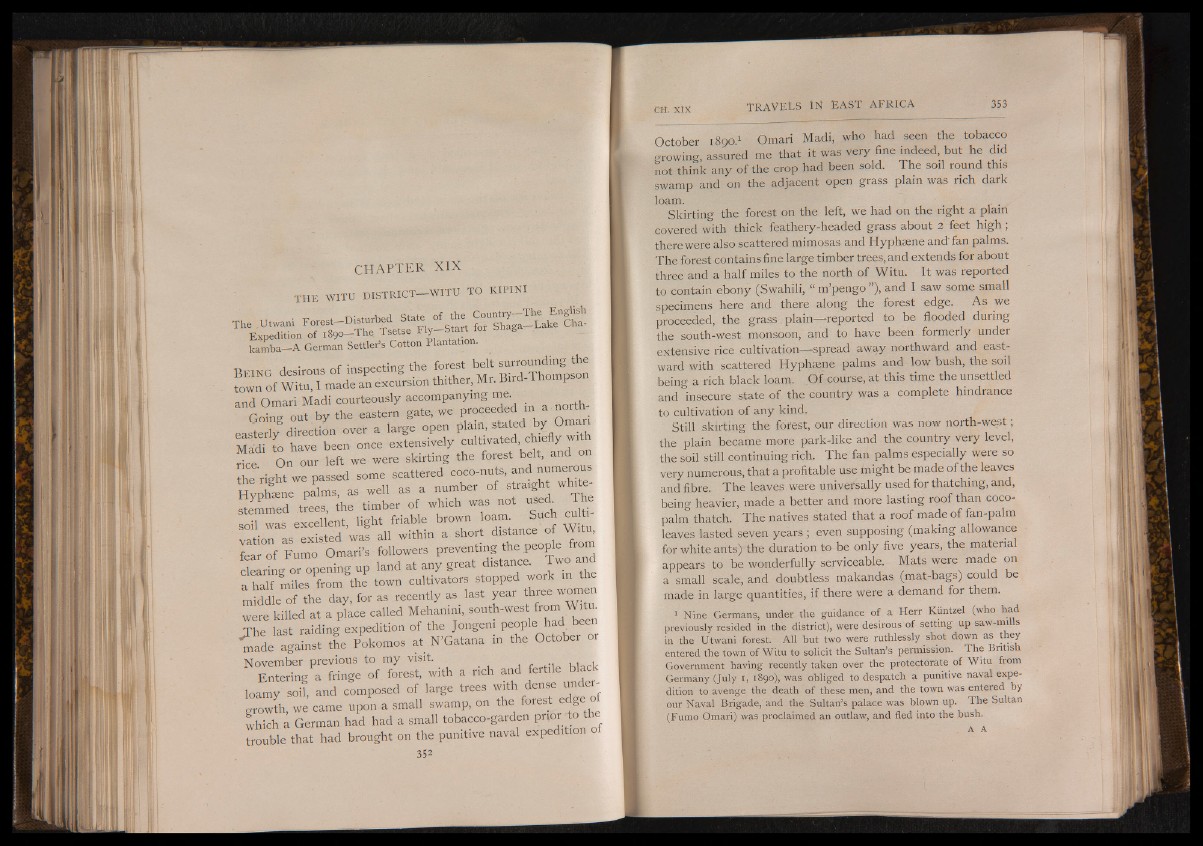
CH AP TER X IX
t h e w i t u d i s t r i c t — w i t u t o k i p i n i
1 f a i « » m I H f | 9 f
B e in g desirous of inspecting the forest belt ° son
own of Witu, I made an excursion thither, Mr. Bird 1 nomp
md Omari Madi courteously accompanying me
Goine out by the eastern gate, we proceeded m a north
easterly direction over a large open plain, stated by °m r
mS T o have been once extensively cultivated, chiefly with
S f On our left we were skirting the forest belt, and on
he right we passed some scattered coco-nuts, and numerous
H y p C n e p L s , as well as a number of straight white-
stemmed trees, the timber of which was not used Th
soil was excellent, light friable brown loam Such cu
vation as existed was all within a short distance of Wit ,
fear of Fumo Omari’s followers preventing the people from
c » r i g o“ opening up land at any great distance. Two and
a half miles from the town cultivators stopped work in the
middle^if the day, for as recently as last year three women
were killed at a place called Mehanini, south-west M |
The last raiding expedition of the Jongem people had been
'made against t L Pokomos f i . N’Gatana in the October or
N o v em b e r p r e v io u s to m y v is it .
Entering a fringe of forest, with a rich and fertile black
loamy soil, and composed of large trees with ense
growth, we came upon a small swamp, on the
which a German had had a small tobacco-garden prfbr to the
trouble that had brought on the punitive naval expedition
October 18901 Omari Madi, who had seen the tobacco
-rowing, assured me that it Was very fine indeed, but he did
not think any of the crop had been sold. The soil round this
swamp and on the adjacent open grass plain was rich dark
loam. .
Skirting the forest on the left, we had on the right a plain
covered with thick feathery-headed grass about 2 feet high;
there were also scattered mimosas and Hyphaene and fan palms.
The forest contains fine large timber trees, and extends for about
three and a half miles to the north of Witu. It was reported
to contain ebony (Swahili, “ m’pengo ”), and I saw some small
specimens here and there along the forest edge. As we
proceeded, the grass plain— reported to be flooded during
the south-west monsoon, and to have been formerly under
extensive rice cultivation— spread away northward and eastward
with scattered Hyphaene palms and low bush, the soil
being a rich black loam. Of course, at this time the unsettled
and insecure state of the country was a complete hindrance
to cultivation of any kind.
Still skirting the forest, our direction was now north-west;
the plain became more park-like and the country very level,
the soil still continuing rich. The fan palms especially were so
very numerous, that a profitable use ftiight be made of the leaves
and fibre. The leaves were universally used for thatching, and,
being heavier, made a better and more lasting roof than coco-
palm thatch. The natives stated that a roof made of fan-palm
leaves lasted seven years ; even supposing (making allowance
for white ants) the duration to be only five years, the material
appears to be wonderfully serviceable. Mats were made on
a small scale, and doubtless makandas (mat-bags) could be
made in large quantities, if there were a demand for them.
1 Nine Germans, under the guidance of a Herr Kiintzel (who had
previously resided in the district), were desirous of setting up saw-mi s
in the Utwani forest. All but two were ruthlessly shot down as they
entered the town of Witu to solicit the Sultan’s permission. The British
Government having recently taken over the protectorate of Witu from
Germany (July 1, 1890), was obliged to despatch a punitive naval expedition
to avenge the death of these men, and the town was entered by
our Naval Brigade, and the Sultan’s palace was blown up. The Sultan
(Fumo Omari) was proclaimed an outlaw, and fled into the bush.